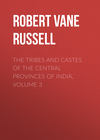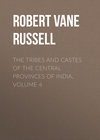Read the book: «The Tribes and Castes of the Central Provinces of India, Volume 3»
Pronunciation
a has the sound of u in but or murmur.
ā has the sound of a in bath or tar.
e has the sound of é in écarté or ai in maid.
i has the sound of i in bit, or (as a final letter) of y in sulky.
ī has the sound of ee in beet.
o has the sound of o in bore or bowl.
u has the sound of u in put or bull.
ū has the sound of oo in poor or boot
The plural of caste names and a few common Hindustāni words is formed by adding s in the English manner according to ordinary usage, though this is not, of course, the Hindustāni plural.
Note.—The rupee contains 16 annas, and an anna is of the same value as a penny. A pice is a quarter of an anna, or a farthing. Rs. 1–8 signifies one rupee and eight annas. A lakh is a hundred thousand, and a krore ten million.
Gadaria
1. General notice
Gadaria, Gādri.1—The occupational shepherd caste of northern India. The name is derived from the Hindi gādar and the Sanskrit gandhāra, a sheep, the Sanskrit name being taken from the country of Gandhāra or Kandahār, from which sheep were first brought. The three main shepherd castes all have functional names, that of the Dhangars or Marātha shepherds being derived from dhan, small stock, while the Kuramwārs or Telugu shepherds take their name like the Gadarias from kuruba, a sheep. These three castes are of similar nature and status, and differ only in language and local customs. In 1911 the Gadarias numbered 41,000 persons. They are found in the northern Districts, and appear to have been amongst the earliest settlers in the Nerbudda valley, for they have given their name to several villages, as Gadariakheda and Gādarwāra.
2. Subdivisions
The Gadarias are a very mixed caste. They themselves say that their first ancestor was created by Mahādeo to tend his rams, and that he married three women who were fascinated by the sight of him shearing the sheep. These belonged to the Brāhman, Dhīmar and Barai castes respectively, and became the ancestors of the Nikhar, Dhengar and Barmaiyan subcastes of Gadarias. The Nikhar subcaste are the highest, their name meaning pure. Dhengar is probably, in reality, a corruption of Dhangar, the name of the Marātha shepherd caste. They have other subdivisions of the common territorial type, as Jheria or jungly, applied to the Gadarias of Chhattīsgarh; Desha from desh, country, meaning those who came from northern India; Purvaiya or eastern, applied to immigrants from Oudh; and Mālvi or those belonging to Mālwa. Nikhar and Dhengar men take food together, but not the women; and if a marriage cannot be otherwise arranged these subcastes will sometimes give daughters to each other. A girl thus married is no longer permitted to take food at her father’s house, but she may eat with the women of her husband’s subcaste. Many of their exogamous groups are named after animals or plants, as Hiranwār, from hiran, a deer; Sapha from the cobra, Moria from the peacock, Nāhar from the tiger, Phulsungha, a flower, and so on. Others are the names of Rājpūt septs and of other castes, as Ahirwār (Ahīr) and Bamhania (Brāhman).
Another more ambitious legend derives their origin from the Bania caste. They say that once a Bania was walking along the road with a cocoanut in his hand when Vishnu met him and asked him what it was. The Bania answered that it was a cocoanut. Vishnu said that it was not a cocoanut but wool, and told him to break it, and on breaking the cocoanut the Bania found that it was filled with wool. The Bania asked what he should do with it, and Vishnu told him to make a blanket out of it for the god to sit on. So he made a blanket, and Vishnu said that from that day he should be the ancestor of the Gadaria caste, and earn his bread by making blankets from the wool of sheep. The Bania asked where he should get the sheep from, and the god told him to go home saying ‘Ehān, Ehān, Ehān,’ all the way, and when he got home he would find a flock of sheep following him; but he was not to look behind him all the way. And the Bania did so, but when he had almost got home he could not help looking behind him to see if there were really any sheep. And he saw a long line of sheep following him in single file, and at the very end was a ram with golden horns just rising out of the ground. But as he looked it sank back again into the ground, and he went back to Vishnu and begged for it, but Vishnu said that as he had looked behind him he had lost it. And this was the origin of the Gadaria caste, and the Gadarias always say ‘Ehān, Ehān,’ as they lead their flocks of sheep and goats to pasture.
3. Marriage customs
Marriage within the clan is forbidden and also the union of first cousins. Girls may be married at any age, and are sometimes united to husbands much younger than themselves. Four castemen of standing carry the proposal of marriage from the boy’s father, and the girl’s father, being forewarned, sends others to meet them. One of the ambassadors opens the conversation by saying, ‘We have the milk and you have the milk-pail; let them be joined.’ To which the girl’s party, if the match be agreeable, will reply, “Yes, we have the tamarind and you have the mango; if the panches agree let there be a marriage.” The boy’s father gives the girl’s father five areca-nuts, and the latter returns them and they clasp each other round the neck. When the wedding procession reaches the bride’s village it is met by their party, and one of them takes the sarota or iron nut-cutter, which the bridegroom holds in his hand, and twirls it about in the air several times. The ceremony is performed by walking round the sacred pole, and the party return to the bridegroom’s lodging, where his brother-in-law fills the bride’s lap with sweetmeats and water-nut as an omen of fertility. The maihar or small wedding-cakes of wheat fried in sesamum oil are distributed to all members of the caste present at the wedding. While the bridegroom’s party is absent at the bride’s house, the women who remain behind enjoy amusements of their own. One of them strips herself naked, tying up her hair like a religious mendicant, and is known as Bāba or holy father. In this state she romps with her companions in turn, while the others laugh and applaud. Occasionally some man hides himself in a place where he can be a witness of their play, but if they discover him he is beaten severely with belnas or wooden bread-rollers. Widow-marriage and divorce are permitted, the widow being usually expected to marry her late husband’s younger brother, whether he already has a wife or not. Sexual offences are not severely reprobated, and may be atoned for by a feast to the caste-fellows.
4. Religion and funeral rites
The Gadarias worship the ordinary Hindu deities and also Dishai Devi, the goddess of the sheep-pen. No Gadaria may go into the sheep-pen with his shoes on. On entering it in the morning they make obeisance to the sheep, and these customs seem to indicate that the goddess Dishai Devi2 is the deified sheep. When the sheep are shorn and the fleeces are lying on the ground they take some milk from one of the ewes and mix rice with it and sprinkle it over the wool. This rite is called Jimai, and they say that it is feeding the wool, but it appears to be really a sacrificial offering to the material. The caste burn the dead when they can afford to do so, and take the bones to the Ganges or Nerbudda, or if this is not practicable, throw them into the nearest stream.
5. Social customs
Well-to-do members of the caste employ Brāhmans for ceremonial purposes, but others dispense with their services. The Gadarias eat flesh and drink liquor, but abstain from fowls and pork. They will take food cooked with water from a Lodhi or a Dāngi, members of these castes having formerly been their feudal chieftains in the Vindhyan Districts and Nerbudda valley. Brāhmans and members of the good cultivating castes would be permitted to become Gadarias if they should so desire. The head of the caste committee has the title of Mahton and the office is hereditary, the holder being invariably consulted on caste questions even if he should be a mere boy. The Gadarias rank with those castes from whom a Brāhman cannot take water, but above the servile and labouring castes. They are usually somewhat stupid, lazy and good-tempered, and are quite uneducated. Owing to their work in cleaning the pens and moving about among the sheep, the women often carry traces of the peculiar smell of these animals. This is exemplified in the saying, ‘Ek to Gadaria, dusre lahsan khae,’ or ‘Firstly she is a Gadaria and then she has eaten garlic’; the inference being that she is far indeed from having the scent of the rose.
6. Goats and sheep
The regular occupations of the Gadarias are the breeding and grazing of sheep and goats, and the weaving of country blankets from sheep’s wool. The flocks are usually tended by the children, while the men and women spin and weave the wool and make blankets. Goats are bred in larger numbers than sheep in the Central Provinces, being more commonly used for food and sacrifices, while they are also valuable for their manure. Any Hindu who thinks an animal sacrifice requisite, and objects to a fowl as unclean, will choose a goat; and the animal after being sacrificed provides a feast for the worshippers, his head being the perquisite of the officiating priest. Muhammadans and most castes of Hindus will eat goat’s meat when they can afford it. The milk is not popular and there is very little demand for it locally, but it is often sold to the confectioners, and occasionally made into butter and exported. Sheep’s flesh is also eaten, but is not so highly esteemed. In the case of both sheep and goats there is a feeling against consuming the flesh of ewes. Sheep are generally black in colour and only occasionally white. Goats are black, white, speckled or reddish-white. Both animals are much smaller than in Europe. Both sheep and goats are in brisk demand in the cotton tracts for their manure in the hot-weather months, and will be kept continually on the move from field to field for a month at a time. It is usual to hire flocks at the rate of one rupee a hundred head for one night; but sometimes the cultivators combine to buy a large flock, and after penning them on their fields in the hot weather, send them to Nāgpur in the beginning of the rains to be disposed of. The Gadaria was formerly the bête noir of the cultivator, on account of the risk incurred by the crops from the depredations of his sheep and goats. This is exemplified in the saying:
Ahīr, Gadaria, Pāsi,
Yeh tinon satyanāsi,
or, ‘The Ahīr (herdsman), the Gadaria and the Pāsi, these three are the husbandmen’s foes.’ And again:
Ahīr, Gadaria, Gūjar,
Yeh tinon chāhen ujar,
or ‘The Ahīr, the Gadaria and the Gūjar want waste land,’ that is for grazing their flocks. But since the demand for manure has arisen, the Gadaria has become a popular personage in the village. The shepherds whistle to their flocks to guide them, and hang bells round the necks of goats but not of sheep. Some of them, especially in forest tracts, train ordinary pariah dogs to act as sheep-dogs. As a rule, rams and he-goats are not gelt, but those who have large flocks sometimes resort to this practice and afterwards fatten the animals up for sale. They divide their sheep into five classes, as follows, according to the length of the ears: Kanāri, with ears a hand’s length long; Semri, somewhat shorter; Burhai, ears a forefinger’s length; Churia, ears as long as the little finger; and Neori, with ears as long only as the top joint of the forefinger. Goats are divided into two classes, those with ears a hand’s length long being called Bangalia or Bagra, while those with small ears a forefinger’s length are known as Gujra.
7. Blanket-weaving
While ordinary cultivators have now taken to keeping goats, sheep are still as a rule left to the Gadarias. These are of course valued principally for their wool, from which the ordinary country blanket is made. The sheep3 are shorn two or sometimes three times a year, in February, June and September, the best wool being obtained in February from the cold weather coat. Members of the caste commonly shear for each other without payment. The wool is carded with a kamtha, or simple bow with a catgut string, and spun by the women of the household. Blankets are woven by men on a loom like that used for cotton cloth. The fabric is coarse and rough, but strong and durable, and the colour is usually a dark dirty grey, approaching black, being the same as that of the raw material. Every cultivator has one of these, and the various uses to which it may be put are admirably described by ‘Eha’ as follows: 4
“The kammal is a home-spun blanket of the wool of black sheep, thick, strong, as rough as a farrier’s rasp, and of a colour which cannot get dirty. When the Kunbi (cultivator) comes out of his hole in the morning it is wrapped round his shoulders and reaches to his knees, guarding him from his great enemy, the cold, for the thermometer is down to 60° Fahrenheit. By-and-by he has a load to carry, so he folds his kammal into a thick pad and puts it on the top of his head. Anon he feels tired, so he lays down his load, and arranging his kammal as a cushion, sits with comfort on a rugged rock or a stony bank, and has a smoke. Or else he rolls himself in it from head to foot, like a mummy, and enjoys a sound sleep on the roadside. It begins to rain, he folds his kammal into an ingenious cowl and is safe. Many more are its uses. I cannot number them all. Whatever he may be called upon to carry, be it forest produce, or grain or household goods, or his infant child, he will make a bundle of it with his kammal and poise it on his head, or sling it across his back, and trudge away.”
8. Sanctity of wool
Wool is a material of some sanctity among the Hindus. It is ceremonially pure, and woollen clothing can be worn by Brāhmans while eating or performing sacred functions. In many castes the bridegroom at a wedding has a string of wool with a charm tied round his waist. Religious mendicants wear jatas or wigs of sheep’s wool, and often carry woollen charms. The beads used for counting prayers are often of wool. The reason for wool being thus held sacred may be that it was an older kind of clothing used before cotton was introduced, and thus acquired sanctity by being worn at sacrifices. Perhaps the Aryans wore woollen clothing when they entered India.
Gadba
1. Description and structure of the tribe
Gadba, Gadaba.5—A primitive tribe classified as Mundāri or Kolarian on linguistic grounds. The word Gadba, Surgeon-Major Mitchell states, signifies a person who carries loads on his shoulders. The tribe call themselves Guthau. They belong to the Vizagapatam District of Madras, and in the Central Provinces are found only in the Bastar State, into which they have immigrated to the number of some 700 persons. They speak a Mundāri dialect, called Gadba, after their tribal name, and are one of the two Mundāri tribes found so far south as Vizagapatam, the other being the Savars.6 Their tribal organisation is not very strict, and a Bhatra, a Parja, a Muria, or a member of any superior caste may become a Gadba at an expenditure of two or three rupees. The ceremony consists of shaving the body of the novice, irrespective of sex, clean of hair, after which he or she is given to eat rice cooked in the water of the Ganges. This is followed by a feast to the tribe in which a pig must be killed. The Gadbas have totemistic exogamous septs, usually named after animals, as gutāl dog, angwān bear, dungra tortoise, surangai tiger, gūmal snake, and so on. Members of each sept abstain from killing or injuring the animal or plant after which it is named, but they have no scruple in procuring others to do this. Thus if a snake enters the hut of a person belonging to the Gūmal sept, he will call a neighbour of another sept to kill it. He may not touch its carcase with his bare hand, but if he holds it through a piece of rag no sin is incurred.
2. Marriage
Marriage is adult, but the rule existing in Madras that a girl is not permitted to marry until she can weave her own cloth does not obtain in the Central Provinces.7 As a rule the parents of the couple arrange the match, but the wishes of the girl are sometimes consulted and various irregular methods of union are recognised. Thus a man is permitted with the help of his friends to go and carry off a girl and keep her as his wife, more especially if she is a relation on the maternal side more distant than a first cousin. Another form is the Paisa Mundi, by which a married or unmarried woman may enter the house of a man of her caste other than her husband and become his wife; and the Upaliya, when a married woman elopes with a lover. The marriage ceremony is simple. The bridegroom’s party go to the girl’s house, leaving the parents behind, and before they reach it are met and stopped by a bevy of young girls and men in their best clothes from the bride’s village. A girl comes forward and demands a ring, which one of the men of the wedding party places on her finger, and they then proceed to the bride’s house, where the bridegroom’s presents, consisting of victuals, liquor, a cloth, and two rupees, are opened and carefully examined. If any deficiency is found, it must at once be made good. The pair eat a little food together, coloured rice is applied to their foreheads, and on the second day a new grass shed is erected, in which some rice is cooked by an unmarried girl. The bride and bridegroom are shut up in this, and two pots of water are poured over them from the roof, the marriage being then consummated. If the girl is not adult this ceremony is omitted. Widow-marriage is permitted by what is called the tīka form, by which a few grains of rice coloured with turmeric are placed on the foreheads of the pair and they are considered as man and wife. There is no regular divorce, but if a married woman misbehaves with a man of the caste, the husband goes to him with a few friends and asks whether the story is true, and if the accusation is admitted demands a pig and liquor for himself and his friends as compensation. If these are given he does not turn his wife out of his house. A liaison of a Gadba woman with a man of a superior caste is also said to involve no penalty, but if her paramour is a low-caste man she is excommunicated for ever. In spite of these lax rules, however, Major Mitchell states that the women are usually very devoted to their husbands. Mr. Thurston8 notes that among the Bonda Gadabas a young man and a maid retire to the jungle and light a fire. Then the maid, taking a burning stick, places it on the man’s skin. If he cries out he is unworthy of her, and she remains a maid. If he does not, the marriage is at once consummated. The application of the brand is probably light or severe according to the girl’s feelings towards the young man.
3. Religious beliefs and festivals
The Gadbas worship Burhi Māta or Thākurāni Māta, who is the goddess of smallpox and rinderpest. They offer to her flowers and incense when these diseases are prevalent among men or cattle, but if the epidemic does not abate after a time, they abuse the goddess and tell her to do her worst, suspending the offerings. They offer a white cock to the sun and a red one to the moon, and various other deities exercise special functions, Bhandārin being the goddess of agriculture and Dharni of good health, while Bharwān is the protector of cattle and Dand Devī of men from the attacks of wild beasts. They have vague notions of a heaven and hell where the sinful will be punished, and also believe in re-birth. But these ideas appear to be borrowed from their Hindu neighbours. When the new rice crop is ripe, the first-fruits are cooked and served to the cattle in new bamboo baskets, and are then partaken of by men. The ripening of the mango crop is also an important festival. In the bright fortnight of Chait (March) the men go out hunting, and on their return cook the game before Mātideo, the god of hunting, who lives in a tree. In Madras the whole male population turn out to hunt, and if they come back without success the women pelt them with cowdung on their return. If successful, however, they have their revenge on the women in another way.9 On festival days men and women dance together to the music of a pipe and drum. Sometimes they form a circle, holding long poles, and jump backwards and forwards to and from the centre by means of the pole; or the women dance singly or in pairs, their hands resting on each other’s waists. A man and woman will then step out of the crowd and sing at each other, the woman reflecting on the man’s ungainly appearance and want of skill as a cultivator or huntsman, while the man retorts by reproaching her with her ugliness and slatternly habits.10













